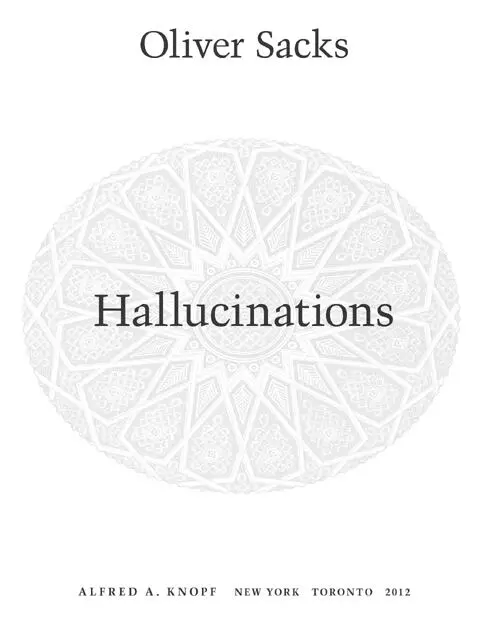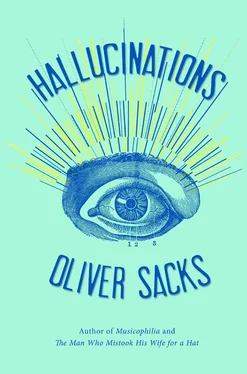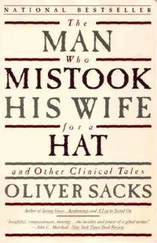

For Kate
When the word “hallucination” first came into use, in the early sixteenth century, it denoted only “a wandering mind.” It was not until the 1830s that Jean-Étienne Esquirol, a French psychiatrist, gave the term its present meaning — prior to that, what we now call hallucinations were referred to simply as “apparitions.” Precise definitions of the word “hallucination” still vary considerably, chiefly because it is not always easy to discern where the boundary lies between hallucination, misperception, and illusion. But generally, hallucinations are defined as percepts arising in the absence of any external reality — seeing things or hearing things that are not there. 1 1 My own favorite definition is that given by William James in his 1890 Principles of Psychology : “An hallucination is a strictly sensational form of consciousness, as good and true a sensation as if there were a real object there. The object happens to be not there, that is all.” Many other researchers have proposed their own definitions, and Jan Dirk Blom, in his encyclopedic Dictionary of Hallucinations , includes dozens of these.
Perceptions are, to some extent, shareable — you and I can agree that there is a tree; but if I say, “I see a tree there,” and you see nothing of the sort, you will regard my “tree” as a hallucination, something concocted by my brain or mind, and imperceptible to you or anyone else. To the hallucinator, though, hallucinations seem very real; they can mimic perception in every respect, starting with the way they are projected into the external world.
Hallucinations tend to be startling. This is sometimes because of their content — a gigantic spider in the middle of the room or tiny people six inches tall — but, more fundamentally, it is because there is no “consensual validation”; no one else sees what you see, and you realize with a shock that the giant spider or the tiny people must be “in your head.”
When you conjure up ordinary images — of a rectangle, or a friend’s face, or the Eiffel Tower — the images stay in your head. They are not projected into external space like a hallucination, and they lack the detailed quality of a percept or a hallucination. You actively create such voluntary images and can revise them as you please. In contrast, you are passive and helpless in the face of hallucinations: they happen to you, autonomously — they appear and disappear when they please, not when you please.
There is another mode of hallucination, sometimes called pseudo-hallucination, in which hallucinations are not projected into external space but are seen, so to speak, on the inside of one’s eyelids — such hallucinations typically occur in near-sleep states, with closed eyes. But these inner hallucinations have all the other hallmarks of hallucinations: they are involuntary, uncontrollable, and may have preternatural color and detail or bizarre forms and transformations, quite unlike normal visual imagery.
Hallucinations may overlap with misperceptions or illusions. If, looking at someone’s face, I see only half a face, this is a misperception. The distinction becomes less clear with more complex situations. If I look at someone standing in front of me and see not a single figure but five identical figures in a row, is this “polyopia” a misperception or a hallucination? If I see someone cross the room from left to right, then see them crossing the room in precisely the same way again and again, is this sort of repetition (a “palinopsia”) a perceptual aberration, a hallucination, or both? We tend to speak of such things as misperceptions or illusions if there is something there to begin with — a human figure, for example — whereas hallucinations are conjured out of thin air. But many of my patients experience outright hallucinations, illusions, and complex misperceptions, and sometimes the line between these is difficult to draw.
Though the phenomena of hallucination are probably as old as the human brain, our understanding of them has greatly increased over the last few decades. 2 2 We cannot be certain whether other animals have hallucinations, although “hallucinatory behaviors” have been observed in laboratory animals as well as in natural settings, as Ronald K. Siegel and Murray E. Jarvik described in their review of the subject.
This new knowledge comes especially from our ability to image the brain and to monitor its electrical and metabolic activities while people are hallucinating. Such techniques, coupled with implanted-electrode studies (in patients with intractable epilepsy who need surgery), have allowed us to define which parts of the brain are responsible for different sorts of hallucinations. For instance, an area in the right inferotemporal cortex normally involved in the perception of faces, if abnormally activated, may cause people to hallucinate faces. There is a corresponding area on the other side of the brain normally employed in reading — the visual word form area in the fusiform gyrus; if this is abnormally stimulated, it may give rise to hallucinations of letters or pseudowords.
Hallucinations are “positive” phenomena, as opposed to the negative symptoms, the deficits or losses caused by accident or disease, which neurology is classically based on. The phenomenology of hallucinations often points to the brain structures and mechanisms involved and can therefore, potentially, provide more direct insight into the workings of the brain.
Hallucinations have always had an important place in our mental lives and in our culture. Indeed, one must wonder to what extent hallucinatory experiences have given rise to our art, folklore, and even religion. Do the geometric patterns seen in migraine and other conditions prefigure the motifs of Aboriginal art? Did Lilliputian hallucinations (which are not uncommon) give rise to the elves, imps, leprechauns, and fairies in our folklore? Do the terrifying hallucinations of the night-mare, being ridden and suffocated by a malign presence, play a part in generating our concepts of demons and witches or malignant aliens? Do “ecstatic” seizures, such as Dostoevsky had, play a part in generating our sense of the divine? Do out-of-body experiences allow the feeling that one can be disembodied? Does the substancelessness of hallucinations encourage a belief in ghosts and spirits? Why has every culture known to us sought and found hallucinogenic drugs and used them, first and foremost, for sacramental purposes?
This is not a new thought — in 1845, Alexandre Brierre de Boismont, in the first systematic medical book on the subject, explored such ideas in a chapter titled “Hallucinations in Relation to Psychology, History, Morality, and Religion.” Anthropologists including Weston La Barre and Richard Evans Schultes, among others, have documented the role of hallucinations in societies around the globe. 3 3 La Barre provided an extended review of anthropological perspectives on hallucination in a chapter published in 1975.
Time has only broadened and deepened our appreciation of the great cultural importance of what might at first seem to be little more than a neurological quirk.
I will say very little in this book about the vast and fascinating realm of dreams (which, one can argue, are hallucinations of a sort), other than to touch on the dreamlike quality of some hallucinations and on the “dreamy states” which occur in some seizures. Some have proposed a continuum of dream states and hallucinations (and this may be especially so with hypnagogic and hypnopompic hallucinations), but, in general, hallucinations are quite unlike dreams.
Читать дальше














